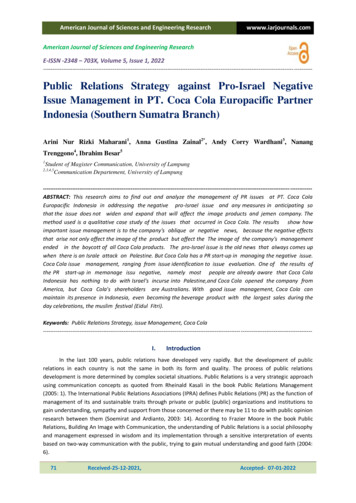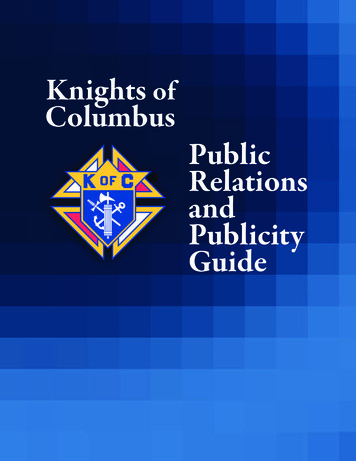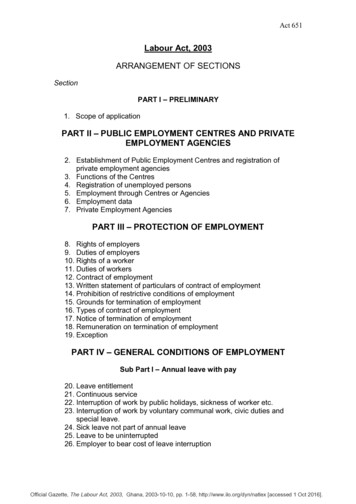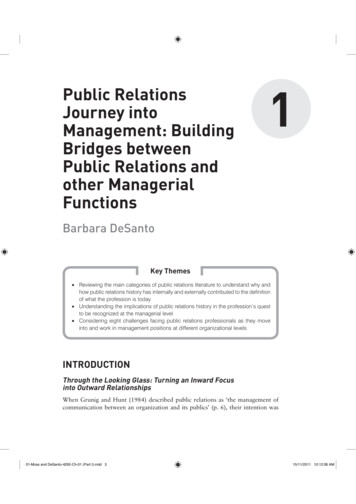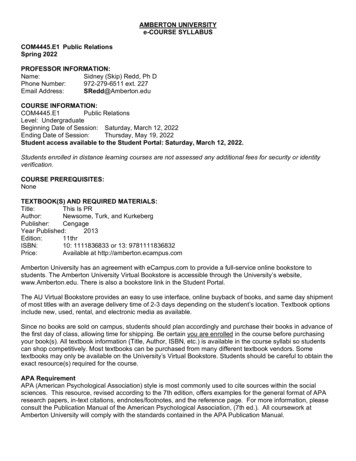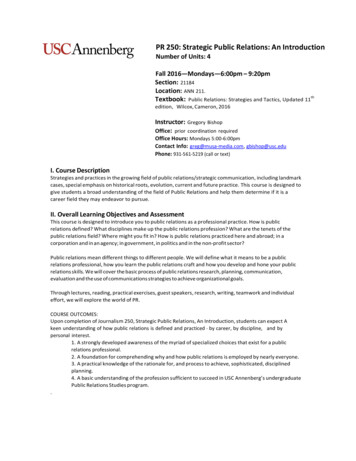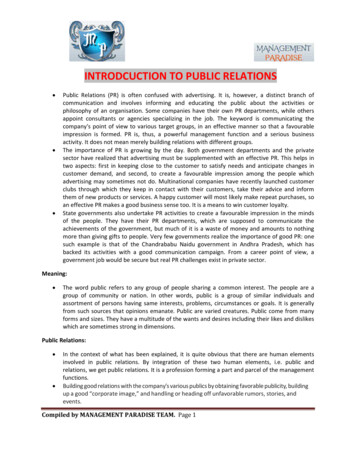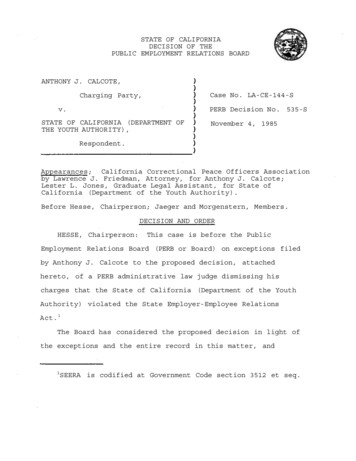
Transcription
STATE OF CALIFORNIADECISION OF THEPUBLIC EMPLOYMENT RELATIONS BOARD)ANTHONY J. CALCOTE,))Charging Party,)v.STATE OF CALIFORNIA (DEPARTMENT OFTHE YOUTH AUTHORITY),Respondent.))))Case No. LA-CE-144-SPERB Decision No. 535-SNovember 4, 1985)))Appearances; California Correctional Peace Officers Associationby Lawrence J. Friedman, Attorney, for Anthony J. Calcote;Lester L. Jones, Graduate Legal Assistant, for State ofCalifornia (Department of the Youth Authority).Before Hesse, Chairperson; Jaeger and Morgenstern, Members.DECISION AND ORDERHESSE, Chairperson:This case is before the PublicEmployment Relations Board (PERB or Board) on exceptions filedby Anthony J. Calcote to the proposed decision, attachedhereto, of a PERB administrative law judge dismissing hischarges that the State of California (Department of the YouthAuthority) violated the State Employer-Employee RelationsAct. 1The Board has considered the proposed decision in light ofthe exceptions and the entire record in this matter, and1SEERA is codified at Government Code section 3512 et seq.
affirms the rulings, findings, and conclusions of theadministrative law judge and adopts his proposed Order.Accordingly, the unfair practice charge in Case No. LA-CE-144-Sis DISMISSED in its entirety.Members Jaeger and Morgenstern joined in this Decision.22
STATE OF CALIFORNIAPUBLIC EMPLOYMENT RELATIONS BOARDANTHONY J. CALCOTE,))Charging Party,v.STATE OF CALIFORNIA (DEPARTMENT OFYOUTH AUTHORITY),Respondent.))))))Unfair PracticeCase N o . LA-CE-144-SPROPOSED DECISION(6/7/85))))Appearances; Lawrence J. Friedman, Attorney, CaliforniaCorrectional Peace Officers Association, for Charging Party;Lester L. Jones, Department of Personnel Administration, LegalDivision, for Respondent.Before Gary M. Gallery, Administrative Law Judge.STATEMENT OF CASEIn this case, after election as officer of a union, anemployee's request for a shift change was denied, he was thentransferred from one unit to another, and his later request forretransfer was denied.PROCEDURAL HISTORYOn June 1, 1984, Anthony Calcote filed the instant unfairpractice charge against the State of California, Department ofYouth Authority.In essence, M r . Calcote charged that herequested a shift change on February 26, 1984, he was informedthat it would be granted.On March 13, 1984, he was electedvice president of the local CCPOA chapter, and was thereafterdenied the shift change.On March 28, 1984, he was transferredThis Board agent decision has been appealed tothe Board itself and is not final. Only to theextent the Board itself adopts this decision andrationale may it be cited as precedent.
to another more stressful unit within the facility.He allegedthat his activities with CCPOA are being held against him andalleged a violation of Government Code section13519(a).1Inresponse to a PERB agent's investigation the charge was amendedon August 29, 1984.The amendment, filed by the CaliforniaCorrectional Peace Officers Association (CCPOA), on behalf ofMr. Calcote, alleges that the employer wrongfully transferredCalcote to the high stress Marshall Unit of the SouthernCalifornia Reception Center and Clinic just two days aftergaining knowledge that Calcote had been elected vice presidentof the local CCPOA chapter, and that the employer haswrongfully refused to transfer Calcote off the Marshall Unitpursuant to his request.The amendment alleges that theinitial transfer and refusal to transfer him back are reprisalsfor protected activities under Government Code section3519(a).A complaint, incorporating the charge and amendmentwas issued on September 20, 1984.On October 9,1to:Section 3519 provides that it is unlawful for the state(a) Impose or threaten to impose reprisalson employees, to discriminate or threaten todiscriminate against employees, or otherwiseto interfere with, restrain, or coerceemployees because of their exercise ofrights guaranteed by this chapter.The State Employer-Employee Relations Act (SEERA or Act) iscodified at Government Code section 3515 et seq. Allreferences are to the Government Code unless otherwise noted.N2
1984, a motion for partial dismissal and an answer were filed2by respondent.The answer denied violation of the SEERA,admitted and denied facts and raised affirmative defenses thatwill be considered elsewhere in this proposed decision.Aninformal settlement conference was held on November 1, 1984,without success.25, 1985.The formal hearing was held on January 24 andPosthearing briefs were filed and the mattersubmitted on April 29, 1985.FINDINGS OF FACTThe State of California, Department of Youth Authority isthe employer within the meaning of Government Code section3513(i).Anthony Calcote is a youth counselor and an employeewithin the meaning of section 3573(c).The Southern Reception Center and Clinic (SRCC) is afacility within the Department of Youth Authority and islocated at Norwalk, California.As the name implies, it servesas a reception facility for youths who have been made wards ofthe Youth Authority.The facility provides diagnostic servicesfor youths committed by a superior or juvenile court and alsooperates an intensive treatment program (ITP) called theMarshall program.2The partial dismissal addressed allegations in thecharge pertaining to Mr. Calcote's medical condition arising in1983. At hearing, the motion was granted insofar as anyfinding of unlawful conduct on the part of respondent regardingsuch event.W3
On the diagnostic side, wards are initially given anorientation and pre-screening.After a week or two, they arethen assigned to one of six live-in units.These units,designed to house 50 wards, are often over crowded, reaching ashigh as 67 wards.After a complete diagnostic study, takingthree to six weeks, the wards are then presented to theYouthful Offenders Board for referral to other institutions,including, possibly, the Marshall program.The Marshall program, in existence for about 8 years, isdesigned for 40 wards, and provides intensive treatment in along-term residential setting for psychotic and suicidalyouths.Enrique Aguilar is the superintendent of the facility.assistant superintendent is Ken Pack.TheAside from the clinicalstaff, reporting to the assistant superintendent from thediagnostic side are the managers, more specifically calledtreatment team supervisors.Each treatment team supervisor isresponsible for two units, called sister units.James Richardson was at all times pertinent hereto, thetreatment team supervisor for the Sutter and Drake Units.senior youth counselor is in charge of each unit.AReporting toRichardson in February and March 1984 were two senior youthcounselors, Gwen Jackson (Sutter Unit) and Thomas Aycock (DrakeUnit).The senior youth counselors provide direction to youthcounselors who are the on-line staff working with the wards.A4
There are two youth counselors on the morning shift, two on theevening shift and one youth counselor on the night shift.The Marshall program also employs youth counselors, whosejob description is the same as those for the diagnosticside.3Because of the intensive nature of the program, there3The job description describes typical tasks as:Trains, counsels and supervises wards intheir daily living and activity programs;develops and implements constructiveprograms for periods of time when wards arenot in a school or vocational work program;provides a planned, scheduled, caseworkprogram of individual counseling for a caseload of approximately ten (10) wards;assists in the diagnostic classifying ofassigned wards and developing appropriatetreatment strategies; conducts small groupcounseling and activity programs withassigned intensive case load; participatesin large group counseling session conductedduring work shift; communicates andcoordinates with other institutional staffabout observations, impressions and workwith assigned wards: repares writtenprogress evaluations, treatment summariesand other reports required by theinstitution and the Youth Authority Board;implements part of treatment plans developedby the treatment team to which assigned;presents diagnostic and treatmentinformation about assigned cases atscheduled case staffings; may presentassigned cases to the Youth Authority Board;assists in planning and carrying outprograms of recreation, intramural sports,and other activities; trains wards incleanliness, personal hygiene grooming;participates in in-service trainingsessions; orders materials and suppliesnecessary for the operation of the unit;maintains custody and necessary discipline;and prepares reports.55
are five staff members on each of the morning and eveningshifts and one at night.The higher ratio of staff to wards atMarshall is because they provide more treatment, conduct largeand small group counseling, family counseling, bio-feedback andother treatment for the wards.Anthony Calcote is a youth counselor at the SRCC.been with the Youth Authority for over seven years.He hasPrior tohis transfer to SRCC, as a youth counselor in 1980, Calcote wasa group supervisor at the Nellis Center.Even after histransfer to SRCC, Calcote volunteered coaching at Nellis duringhis off-work time.Calcote was on industrial disability leave4in July, August and September 1983.In February 1984 Calcote was working the relief shiftbetween the Sutter and Drake Units.days off of other counselors.This position covers theCalcote worked three days a weekat the Sutter Unit and two days a week at the Drake Unit.Calcote's scheduled days off were Thursday and Friday.Calcote's relief position was one of six regular full-timepositions at the Sutter Unit.Another position was held by aMr. Radillo, who worked the 5:45 a.m. to 1:45 p.m. shift.Radillo's days off were Wednesday and Thursday.A memorandum of understanding with the CCPOA requires the4In May 1984 Calcote obtained a Worker's CompensationAppeals Board Award for cardiovascular asttrointestinal and"psyche" injuries leading to high blood pressure.6
facility to give employees 14 days notice of any assignmentchange.To meet this requirement, and to publicize the shiftstaffing for a month in advance at Sutter and Drake, the senioryouth counselors in the sister units work up a schedule andwith Richardson's concurrence, post the schedule by thefifteenth of each month.Unforeseen circumstances will requirea revision to the schedule that is finalized by the end of themonth.For February 1984 Radillo and Calcote were shown on theshift assignments set forth above.5Radillo was sick and off work on February 18 and 19, hereturned to work on February 20 and 21, and then was off on hisscheduled off days February 22 and 23.Sometime during thisperiod Radillo notified Richardson that he would be off onextended illness.He was scheduled to be off on vacation forthe balance of the month.It was not known when he wouldreturn.Calcote first approached Gwen Jackson about moving intothe position held by Radillo.evenings with his son.the change.He mentioned he wanted to spendShe told him she had no problem withJackson testified that Richardson also indicatedthat there was no problem.As treatment team supervisor,Richardson had the final say on shift assignments.Aguilar wasnot involved in any shift assignments.5A11 date references are to calendar year 1984 unlessotherwise noted.7V
On February 26 Calcote submitted a written request toRichardson for placement into Radillo's vacant position atSutter.He wrote that he felt his presence would bring morestability, harmony, and security to the Sutter team.Heindicated his ability to change immediately, and requested aresponse in writing.Richardson responded in writing on February 27.He stated:Due to the sudden departure of Mr. Radillo,we have on a temporary basis moved youthcounselor Mendoza into his shift for themonth of March. Your interest in the shiftwill be considered as we evaluate both unitneeds in preparation for fillingMr. Radillo's position on a more permanentbasis.Mendoza was put into the position, said Jackson, because hehad days off the same as the vacancy and there would be lessimpact on other personnel.If Calcote were placed into theposition, it would have affected another person in either unitas the Calcote position was the relief position between thesister units.Also, if Calcote had been put into the position,then a majority of the remaining positions at Sutter would have6been black.6There would then be only one white male at theSutter Unit. Mendoza did not need a 14-day notice as he wasalready on the morning shift.Thus, his placement affected noother employees and gave them an additional Hispanic.6The ethnic population is about 35 percent black and33 percent Hispanic.8
Aycock testified that Mendoza's classification was that ofa limited term employee.He did not have permanent full-timestatus and was more flexible.Because Mendoza's work schedulecoincided with Radillo's it was easier to place Mendoza intothat slot.7Also, they were attempting to meet an ethnicstandard by adding a Chicano to the unit.The schedule wasmade up the last week of February.Richardson also testified that Mendoza was placed into theRadillo position in March because his work schedule was thesame.While evidencing uncertainty about where Mendoza hadbeen in February, Richardson testified that Mendoza, who hadpreviously been an intermittent employee, was not at theinstitution for several months prior to February, but returnedthat month as a limited termemployee.8Richardson saidMendoza had worked for him before and as a limited termemployee would provide more stability to the position and wastherefore a good choice to fill in for the Radillo vacancy.Aycock testified that Mendoza had originally been scheduled(prepared in mid-February) for the limited term slot on the7Mendoza's classification is within the unit covered bythe memorandum of understanding and would be entitled to 14days notice of schedule change.8Around this time the facility commenced a classificationof limited term employees. Whereas intermittent employees andpart-time employees are limited to under 40 hours without aregular work schedule and on an as needed basis, the limitedterm employee may be hired on a regular schedule for up to sixmonths.99
March schedule.Documentation submitted by the department forthat month shows Potts in the S31 (temporary) slot having thesame shift and days off as the Radillo slot.The ElectionCalcote testified that on March 13 he was elected vicepresident of the local chapter of the CCPOA.There is noevidence of any prior employee organizational activity byCalcote.Hector Rodriquez, a youth counselor at Marshall, had servedfor some time as both president of the local chapter and aschief job steward.In March 1984, Rodriquez secured approvalof a transfer to the Washington Ridge facility in NorthernCalifornia.Rodriquez testified that the election for officerswas more a confirmation by the chapter board of directors onnominations put forth by the president.As to the timing, andthus notice to management at the facility of the new officers,his testimony differs from that of Calcote, Robert Collier andRuben Gilbert.Rodriqueztestified that the election was heldon March 8, and that the next day he went to Aguilar's officeand told him the results of that election.He told Aguilarthat Calcote was going to be vice president, Gilbert was to bepresident and that Collier was to be job steward.March 9 washis last day at the facility, he said, and on that day all hisduties passed on to others.Calcote and Gilbert testified that the election was held onMarch 13.Collier testified that it was on March 14.10
Aguilar said that Rodriquez did tell him that Collier wouldbe taking Rodriquez1 place as job steward when he came in tosay goodbye around March 9, but denied that Calcote's name wasmentioned in that conversation.The first time he knew ofCalcote's position with CCPOA was at the March 26 meeting whichis described later.Further confusion on the issue is presented by CCPOA'snotice regarding the election.By memo on the chapterletterhead, dated March 16, 1984, Gilbert notified CCPOAmembers that he had taken over as president, Calcote had beenconfirmed as vice president and Collier would handle employeegrievances.Despite the date typed, Gilbert testified that thememo had been typed on March 14 and that he delivered it to thesuperintendent's office on March 14.error, he said.The March 16 date was anThe superintendent's secretary placed thedocument in her in-coming mail when he delivered it to her, hesaid.Emma Moretz, secretary to the superintendent, testifiedthat the March 16 letter from Gilbert was date stamped onApril 4, 1984, in the lower right hand corner, and that herpractice was to date stamp any document coming into thesuperintendent's office on the day she received it.Thus, herrecords indicate that the superintendent's office received thedocument on April 4, 1984, (indeed the copy provided bycharging party's counsel had the date stamp in that place.)11
Finally, by memo dated March 15, 1984, Arthur Nettles, theDepartment of Youth Authority's Equal Employment OpportunitiesDivision Manager, wrote to Collier regarding Collier's statusas EEO Counselor.Nettles' office is in Sacramento.BecauseNettles had learned on March 14, 1984, that Collier had becomejob steward for CCPOA, Nettles advised Collier that he couldnot hold both positions.The document indicated a copy was togo to Aguilar.The inconsistency of charging party's evidence on theprecise date of the election undermines the credibility of bothRodriquez and Calcote.Rodriquez on the one hand testifiedthat that election took place on March 8.he told Aguilar of Calcote's election.that he was elected on March 13.On March 9, he saidCalcote, however, saidOn March 14 Calcote said hetold Jackson of his election because he thought she would be,proud of him.He thought she would be surprised as he "wasn'trunning for anything."Had Calcote been in the running on the8th, and elected then, why would he wait until March 14, fivedays later, to relate his election to Jackson?Rodriquez, who was brought in from his assignment inNorthern California, appeared later at the hearing and thus didnot hear the testimony of his fellow employees.He knew theissue in this case, however, and related on the stand, thatfirst he told Aguilar of Calcote's election.This isquestionable since Calcote was only to serve as vice president12
while others, Gilbert and Collier, were to serve in more directfunctioningroles as president and job steward.Thus, I donot credit Rodriquez over Aguilar regarding what was said onMarch 9.Therefore it is found that Rodriquez did tell Aguilarthat Collier was going to be job steward, but made no mentionof Calcote's position.As to the March 16 letter, I credit Moretz over Gilbert.In the face of a typed letter dated March 16 and date stampedas received April 4 in a manner consistent with businesspractice and contemporaneous with the event as to whenreceived, charging party would have a finding drawn that theletter was delivered on March 14.This contention is more inkeeping with a contrived design to place knowledge on the partof management of an event that coincides with the March 14scheduling regarding the April schedule.Because of thisinherent inconsistency in the testimonial and documentaryevidence, I find that charging party has failed to establishknowledge by a preponderance of the evidence as it wasobligated to do.PERB Regulation section 32178.Insofar as the Nettles' letter is concerned, theacknowledgement on March 15 by a Sacramento based employee ofthe department that Collier was elected to serve as job stewardis consistent with Aguilar's acknowledgement of receiving thatinformation on March 9 from Rodriquez.13It serves no basis for
finding that Calcote's election was likewise known to Aguilar,Richardson or Aycock.Calcote testified that on the morning of March 14 Jacksontold him he had gotten the position.Later he testified thatthose were not her exact words but he did have thatimpression.He told her about being elected to the vicepresidency of the CCPOA.Calcote thought that she would besurprised as "he really wasn't running for anything".They arefriends, he said, and he thought she would be "proud of him".At 11:00, he said, Jackson said she was meeting with Richardsonand Aycock.That afternoon Aycock told him that he did not getthe position he had requested, but gave no reason for thedenial.Calcote further testified that Mr. Martinez, another youthcounselor, told him that same day that Richardson stopped himon the way in and told him that he, in fact, was going to getthe shift.Martinez had told Calcote previously that he wasgoing to get the position.(Martinez was working the 2 p.m. -10 p.m. shift at Drake in March.)Jackson testified that she thought she learned of Calcote'selection as vice president sometime in February.First,Collier told her he was going to take over as job steward andlater Calcote told her that he was going to be vice president.However, she said, the fact of his election was not known whileshe was involved in scheduling.Nor was the fact that the14
CCPOA elections had taken place discussed at the meetings withAycock and Richardson when scheduling was being done.She wasnot cross-examined on the scheduling meetings.While Jackson was wrong about learning of Calcote'selection as early as February, I found her to be credible inher testimony generally.Obviously a friend of Calcote's, andsupportive of his role as a youth counselor, her denial of anydiscussions of Calcote's election at the scheduling meetingappeared truthful.It is found that Jackson did not carry thefact of Calcote's election into the meeting on March 14regarding scheduling.Both Richardson and Aycock testifiedthat the meeting did not involve a discussion of CCPOAelections.Calcote was left on the same relief schedule for April thathe had occupied for February and March.This time, however,Mendoza was returned to the S31 (temporary) slot and Martinez,who had been at the Drake Unit, was moved into the Radilloslot.Thus the Sutter Unit had two Hispanic employees, workingthe same shift and with the same days off.The next day, (after the election) Calcote testified,Jackson told him she did not know why he did not get the9position.He spoke to Richardson and was told thatRichardson wanted a Chicano in the position.9day.The March schedule shows that Calcote was off on that15
On March 21 Calcote wrote to Richardson asking for ananswer in writing as to why he did not get the position.Thisfollowed a meeting with Assistant Superintendent Pack atCalcote's request.Calcote thought the reasons were other thanhaving Chicanos on the unit.Pack called Richardson in andasked why the request was not granted.Richardson told themboth that he wanted a Chicano in the position and Pack saidthat was the way it was going to be.By way of showing disparate treatment, Calcote testifiedthat John Grijalva was given a shift change because his wifewas having a baby.Calcote told Jackson that he wanted theshift change to spend evenings with his son as he was a singleparent, but he did not convey that fact to Richardson in hiswritten February 26 request for shift change.Calcote did notknow any other employees who were single parents.Aycock testified that at a March 14 meeting it was decidedto place Martinez in the Radillo slot because he was afull-time budgeted employee.S31 slot.Mendoza was placed back into theThe reason, said Aycock, was Mendoza was a limitedterm employee and as such did not lend the desired permanency.As a limited term employee, he could be terminated if the headcount of wards dropped.By placing Mendoza in the S31 slotthey maintained the flexibility of his classification andMartinez then gave them the desired permanency.16
Aycock was not aware of the election outcome and there wasno discussion ofCCPOA.The final decision was made to causethe least amount of impact on employees.In fact, Martinez didhave a shift change as he had worked the 2:00 - 10:00 p.m.shift at Drake the month of March (and February).As a result of the new schedule, the permanent staff atSutter consisted of three black males, a black female, aChicano, and a white male.They also had Mendoza at the SutterUnit in the limited term position.At the Drake unit they hadfour blacks, a white male and a white female.Also at Drake aSpanish case worker, who served as translator, worked from anoffice at the unit.She was visibly present and met with thewards, said Aycock, and did contribute to the ethnic needs.In May Mendoza was assigned to the Drake Unit.The schedule for May was prepared within the first twoweeks of April and was posted by the middle of that month.Martinez was scheduled for the S2 (Radillo) slot.Aycock saidthey found out in the last week of March that Martinez was tobe promoted and was to go to the YTS effective May 1.Jacksonwas promoted to treatment team supervisor and Grijalva hadrequested a change in classification from regular tointermittent employee.Richardson said he approached theadministration because of the large number of personnel changesthat occurred.King, a black limited term employee, was placed17
in the Radillo slot.Calcote was not considered becauseeffective April 16 he was transferred to the Marshall Unit.King filled the S2 slot for one month.In June Fernando Juarez came to the Sutter Unit and filledthe slot held by King.Stiggers, a black female, came from thePico Unit and helped fill the ethnic needs.Juarez had beenselected in early April or May but it took some time beforethey could get him to the Sutter Unit.Juarez was desiredbecause of his good history in working with gang problems as hehad experience as the institutional game coordinator and hadextensive knowledge of the ward population.The Cole TransferTim Cole is a youth counselor who for the last five yearsworked at the Marshall program.For two years prior to that hewas at the Ventura facility, where for six months he worked inthe receiving side and the remainder in the intensive treatmentprogram.Cole, who is white, was transferred to the SutterUnit in April 1984.Cole said that about a month before he wastransferred, his caseload was reduced and he suspectedsomething was happening.Aguilar told him that he was to betransferred to the diagnostic side.Cole filed a grievance onthe transfer as he disagreed with the explanation.The reasonsgiven were that it would enhance his education at the facility,and that it was consistent with Aguilar's goal to move staffmembers from the Marshall side to the diagnostic side.18Cole
believed that his six months experience in the receiving unitat Ventura was sufficient education.There were othercounselors at the Marshall site with more seniority, said Cole,including Delbert Jackson, Larry Floris and Bill Lewis.Colealso testified that two other people were transferred from theMarshall Unit to the diagnostic side, and he was under theimpression that the same number of people transferred to theMarshall Unit from the diagnostic unit.Cole said he was theonly white counselor at Marshall when he was transferred andthere were other white counselors at Sutter, the unit to whichhe transferred.Aguilar said the decision to transfer Cole to thediagnostic side was made in the first week of March before hehad any knowledge of Calcote's election.Cole had been at theMarshall program for over three years and it was in keepingwith Aguilar's goal that the transfer was made.Jackson andFloris "will be transferred," said Aguilar, and "seniority hasno input on the policy."All of the counselors will be rotatedout of the Marshall program.Cole coming to Sutter, saidAguilar, would lend ethnic balance to that program, although hedid not know the ethnic balance at Sutter at the time of thetransfer.Richardson did not know that Cole was coming to theSutter Unit until the middle of March.Ed Fox, senior youthcounselor at Marshall, said that the three individuals who wereat the top19
of the program, recommended Cole's transfer.Those three wereOwens, Atesalp and Fox.Calcote TransferCalcote said he learned from Tim Cole that he was going tobe transferred to Marshall.The next day Jackson called him upto Richardson's office and they gave him a memo indicating histransfer to Marshall.The memo, dated March 28, stated histransfer to Marshall effective April 16.Richardson noted inthe memo that the assignment would provide Calcote with anopportunity to use his treatment and recreational skills in along-term setting.Calcote was unhappy with the reassignment.He wasconcerned that it would be more stressful as he was unsure ofhis ability to work in an unfamiliar setting.He felt that hewas being set up by the administration to fail because of thetype of wards and the duties the job entails.Aguilar testified that the decision to assign Calcote toMarshall was made in the week before March 26.(His basis ofrecall was that he was able to tell Collier that Collier wouldnot be transferred to Marshall.)Aguilar testified that thedecision to transfer Calcote to Marshall was that, of the namespresented to him, the only one that he could recall,Rudy Hernandes had already been at Marshall and did not fillthe needs of the program.The Marshall program had beenlooking for someone who could program and organize wards; sowhen Calcote's name20
appeared, Aguilar knew he was a person who was involved inprogramming and handling athletic activities.Calcote was anathlete and knew about officiating at games.These were someof the main factors in the decision.The date set for histransfer was April 16 because management had to give two weeksnotice of the transfer and could not do that by the end ofMarch.Calcote's blood pressure was not taken into account in thedecision to transfer Calcote, said Aguilar, because he did notknow of the fact.Calcote's transfer was consistent with the administration'spolicy of transfer, said Aguilar.That policy is set fort
PUBLIC EMPLOYMENT RELATIONS BOARD . ANTHONY J. CALCOTE, Charging Party, v. STATE OF CALIFORNIA (DEPARTMENT OF THE YOUTH AUTHORITY), Respondent. Case No. LA-CE-144-S PERB Decision No. 535-S November 4, 1985 Appearances; California Correctional Peace Officers Association by Lawrence J. Friedman, Attorney, for Anthony J. Calcote;


